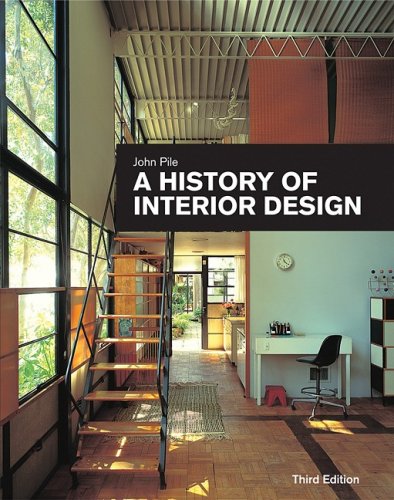Recommended Reading: John Pile’s “A History of Interior Design” (3rd Ed.)
 There comes a point in your exploration of a subject where it becomes important; when you’re ready to swim into the deep end of the pool. It’s no longer enough to just look at pretty pictures and base your opinions solely on what other people (even bona fide experts) have to say. You want to know enough of the fundamentals that you can start drawing your own conclusions. For interior design, this book is a gateway into that next level.
There comes a point in your exploration of a subject where it becomes important; when you’re ready to swim into the deep end of the pool. It’s no longer enough to just look at pretty pictures and base your opinions solely on what other people (even bona fide experts) have to say. You want to know enough of the fundamentals that you can start drawing your own conclusions. For interior design, this book is a gateway into that next level.
“A History of Interior Design” is a bit of a paradox: it is a very thorough overview. I know it sounds like a contradiction, but the author looks at the full history of interior spaces, from the very first cave dwellings. He continues through the first known habitations of the oldest settled villages, through the temples, palaces, and houses of the first great civilizations of Egypt, Sumeria, Greece and Rome. Because he is working with archaeological evidence in many cases, Pile must focus on the larger buildings and less on the homes of everyday people. For Europe, the history of church design is covered in great detail, especially as these are landmarks that can still be visited today. Once the premodern and modern areas are covered, he is able to go into more detail about more types of buildings, and start talking about specific architects and designers, because there are known histories for them. So it is an overview, but the book fleshes out each topic well enough so that you can start reading more deeply into topics of special interest.
The author knows when to supply essential details, so that he can then continue to talk meaningfully about a subject without confusing the lay reader. For example, he shows diagrams of the orders of Greek architecture, and describes the parts and functions of churches. Things like this are important of you’re going to understand the evolution of Western architecture.
Reading this, I was struck by how much science and technology really shape the worlds we make for ourselves. Special breakthroughs like the development of the arch, the vault, and the dome can only occur because an architect could plan them, and construction methods were developed so they could be built. When you read about how the mathematical and engineering problems were solved, it makes you marvel at how clever we humans can be.
The sociological context that Pile provides is also very helpful. Because the houses of most people were constructed of wood or mud brick, and have therefore been lost, much of the historical record consists of palaces and religious buildings. As wealth becomes more distributed to a bigger portion of society with the rise of the middle class, buildings, furniture, and tools like cooking implements show up more in museums and collections. When you see the first use of indoor plumbing arrive, you really get a sense of the squalor most people (even the wealthy) lived with. One startling moment: when you read a complaint in a French society lady’s letter about the stink in the queen’s chambers at Versailles!
A big surprise for me was how much I enjoyed reading about design approaches I don’t personally like, like Baroque and Rococo. My tastes are a lot more modern. But once I learned about the knowledge and craftsmanship developments that gave rise to styles such as these, I became a lot more sympathetic towards them. At least, I can now see them as important phases in western design history.
Pile provides excellent definitions of modern design developments. If you’ve ever been confused about the difference between modernism and minimalism, or postmodernism and deconstructivism, then this book will help. I loved his definition of kitsch: “…design that is deliberately foolish and tasteless in an effort to reflect the human appetite for mischief”. That pretty much sums it up!
At 450+ pages, this is not light reading: this is a mission! But with Pile’s clear, matter-of-fact prose and liberal illustration with colour and black and white images (a must for a topic like this), it is a very joyful journey. And oh, the images! Gorgeous colour shots of massive church interiors, sweeping views of modern museums and ground breaking house designs abound – sometimes 3 or 4 per page. Photos of significant furniture pieces are a strong presence as well. There are also a lot of plan views for important buildings, which help immensely. In short, this book is very accessible for anyone with a real drive to learn about interior design. The book also comes with an interactive timeline on CD, which is helpful if you want to step back and get a high-level overview.
For me, learning about interior design is not just about trying to fix up my place a bit. How we organize and decorate our inner spaces says a lot about who we are, how we live, and what our dreams are. Looking at what was done in the past, and more importantly, understanding it, can provide a deeper connection to our ancestors, and to humanity as a whole.
by Jennifer Priest
Follow me on Google +

No comments yet.
Add your comment